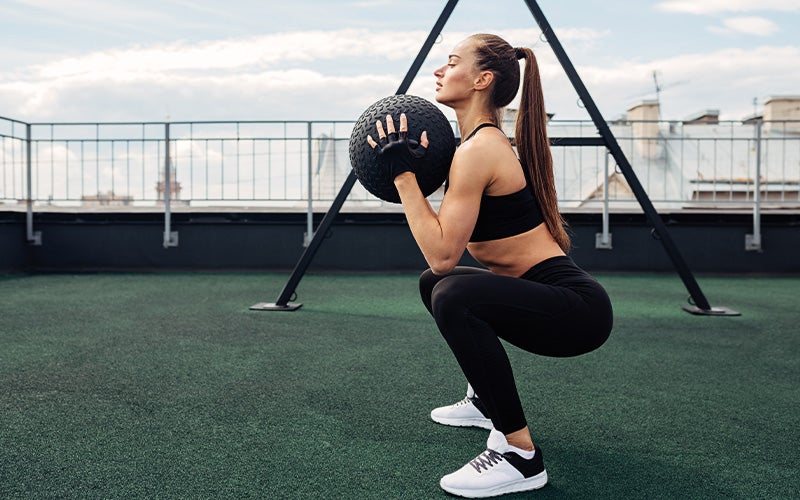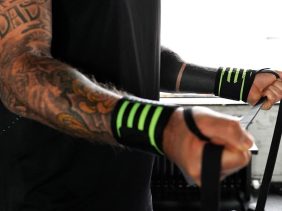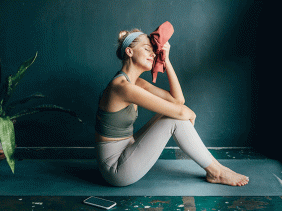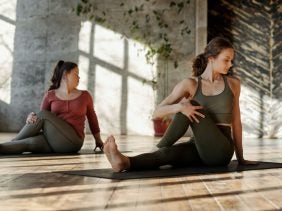9 Moves to Transform Your Abs, Legs, and Butt
 © foodspring
© foodspring
Your glutes are the biggest and strongest muscles in the body, and your thighs can hold their own, too. Movement is nearly impossible without your core doing its job. So it stands to reason that working these major muscle groups should be a high priority. Not surprisingly, a lot of specific exercises do double- or triple-duty, working more than one area at a time.
How to make the most out of these moves
Exercise is just like comedy — timing is everything. Or so suggests research on how to maximise the effectiveness of your workouts. That’s because your muscles need time to recover and heal from big efforts. Workouts are essentially controlled damage. By breaking the fibres in the muscles through lifting and movement, it forces those muscles to make new muscle fibres that are stronger and more numerous.
But what’s the right amount of rest? Researchers from the United States and the Netherlands sought to find out. They took 21 men on the younger side who had experience with resistance training. First, the researchers established a baseline for the participants that included a 1 rep max bench press and back squat, a 50% 1 rep max bench press to failure, and muscle thickness using ultrasound imaging. Over 8 weeks, they all did the exact same workout, but changed one variable: one group had short 1 minute rest intervals, and the other got longer 3 minute rest intervals. “Maximal strength was significantly greater for both 1 rep max squat and bench press for 3 minute rest compared to 1 minute rest,” the researchers write. The difference in muscle thickness was stark, too. The people who had longer rest had become bigger, which suggests that “longer rest periods promote greater increases in muscle strength and hypertrophy,” the researchers conclude.
Related: Glute exercises to stand up and cheer for
Then you have to factor in volume, meaning how much total weight you lift in a week. Is it better to split up the weight across multiple workouts, or is it ok to get it done in a day? A review of research that looked at 25 studies on the subject found that, when you don’t factor in volume, more frequent workouts has a slight advantage. But “there is strong evidence that resistance training frequency does not significantly or meaningfully impact muscle hypertrophy when volume is equated, wrote the American and Australian researchers in the Journal of Sports Sciences. “Thus, for a given training volume, individuals can choose a weekly frequency per muscle groups based on personal preference.”
Regardless, you’re going to need to have enough protein to build all that new muscle, which is where our protein powders and snacks come in.
9 Moves for Your Abs, Legs, and Butt Workout
Always try to do a 10 minute warm up before doing any ab, thigh, or butt workout. Choose 4 to 6 exercises per workout session, changing up the mix as the weeks go on. Do 3 to 4 rounds of 30 seconds to 1 minute, going quickly from one move to another, and resting 1 to 3 minutes between rounds.
Related: Why you need to warm up and how to do it
You can also do an interval-style workout, doing all of the moves for 20 seconds, with 10 seconds of rest between moves.
- Plank with rotation
Start in a low plank, forearms on floor, parallel to shoulder blades and touching each other. Rotate body to the right, letting feet roll to right, as you reach right fingertips to ceiling. Reverse and repeat on left. Continue at a controlled pace.
- Leg Lifts
Lie with legs together and straight, feet neutral, toes gently pointed to ceiling, palms pressing into floor. Maintaining soft knees, with low back pressed into floor, lift legs until soles of feet are facing ceiling, then lower legs until heels tap floor and immediately lift.
- Mountain climbers
Start in a high plank, hands below shoulders, a straight line between heels, shoulder blades, and head. Draw right knee toward chin, then switch legs so only one foot is on the ground at a time. Continue quickly. If that’s too challenging, slow it down, picking up one foot and replacing it before reversing and repeating.
- Sumo Squats
Stand with feet slightly wider than shoulder width apart, keeping chest up and shoulder blades back and down, drop butt back and down, bringing hands together at face level as you drop, until hips are lower than knees, then reverse and repeat.
- Around-the-World Lunges
Stand with feet shoulder width apart, to start. Step left foot forward into a lunge, then return to start. Step left foot to the side for a lateral lunge, then back to start. Step left foot back for a reverse lunge, and return to start. Finally, step left foot back and behind right leg for a curtsey squat, and return to start. Repeat on the right foot. Then repeat.
- Squat Jumps
Stand with feet shoulder width apart, to start. Drop into a lunge, then swing arms upward and jump, landing softly and immediately dropping into a squat. Repeat.
- Reverse hyperextensions
Lie on stomach, arms and legs outstretched, face down, to start. Engage abs and raise arms and legs up out, keeping your gaze on the floor. Reverse to start. Continue at a controlled pace.
- Glute Bridges
Sit on the floor, knees bent, feet on floor, hands under shoulders with fingertips pointing at heels, to start. Press through heels and raise hips toward the ceiling until your body creates a straight line between shoulders, pelvis, and knees. Then return to start. Continue at a controlled pace.
- Standing Hip Abduction
Stand feet shallower than hip width apart, knees soft, elbows at shoulder-height and finger tips overlapping and close to sternum, shoulder blades back and down. Start by shifting weight onto your left leg and slowly raise your right leg to the right side as far as possible while maintaining balance. Reverse to start for one rep. Do 3 sets of 15 reps. Complete reps on one side before switching sides. If needed, lightly hold a wall or rig for balance.
More healthy living tips from foodspring:
- Weight Loss Workout Plan: What you need to know
- How to Lose Weight with Yoga
- How to lose weight without dieting: 13 tips to your feel-good body
- Create your ideal weight loss meal plan and work towards your feel-good body!
- Weight Lifting For Weight Loss
Sources for this article
We at foodspring use only high-quality sources, including peer-reviewed studies, to support the facts within our articles. Read our editorial policy to learn more about how we fact-check and keep our content accurate, reliable, and trustworthy.





























